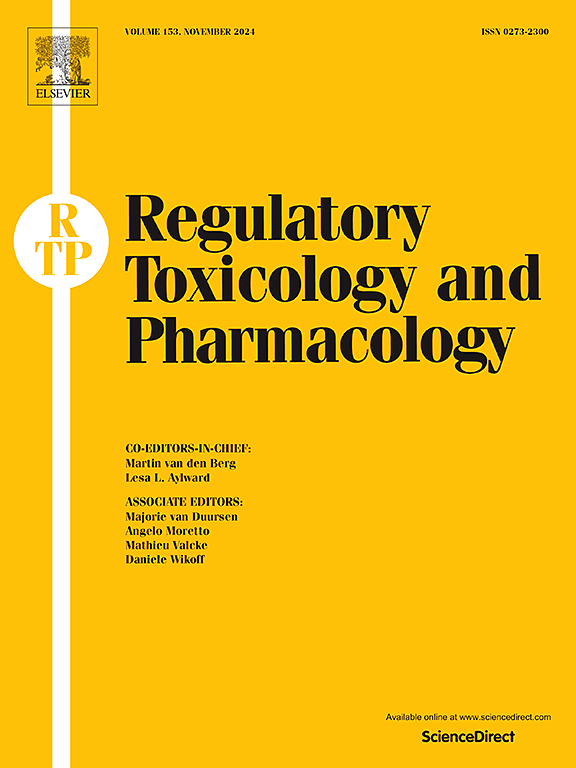Substantiating chemical groups for read-across using molecular response profiles
IF 3.5
4区 医学
Q1 MEDICINE, LEGAL
引用次数: 0
Abstract
By grouping structurally similar chemicals, toxicity endpoints from data-rich substances can be read across to data-poor substances, supporting environmental and human health risk assessment without animal testing. However, structural similarity alone is insufficient, and additional supporting data can strengthen a grouping justification. This study aimed to demonstrate how multi-omics bioactivity data can increase confidence in a grouping hypothesis, where the bioactivity profiles can reflect a chemical's mode(s) of action. We investigated three structurally similar phthalates and three uncouplers of oxidative phosphorylation, applying structure-based grouping approaches and short-term exposures of the ecotoxicological test species Daphnia magna to generate multi-omics data. Bioactivity similarities between the ‘omics responses to chemical exposure were assessed using t-statistics comparing treated samples to controls and visualised using hierarchical cluster analysis. Conventional structure-based grouping did not assign the phthalates and uncouplers into two anticipated categories, with the structurally more diverse uncouplers often assigned into multiple groups. Following bioactivity thresholding, which removed one uncoupler as it induced minimal molecular responses, bioactivity profile-based grouping of the remaining five substances correctly separated them into two chemical classes with high replicability confidence. However, a plausible toxicological interpretation of the reduced set of functionally annotated molecular features driving the grouping was attempted, although of limited success. This study demonstrates how multi-omics bioactivity profiles can increase confidence in chemical grouping and investigates a potential strategy for plausibly interpreting ‘omics data.
利用分子响应谱确证化学基团的读取
通过对结构相似的化学品进行分组,可以将数据丰富的物质的毒性终点解读为数据不足的物质,从而支持在不进行动物试验的情况下进行环境和人类健康风险评估。然而,结构相似性本身是不够的,额外的支持数据可以加强分组的理由。本研究旨在证明多组学生物活性数据如何增加分组假设的可信度,其中生物活性概况可以反映化学物质的作用模式。我们研究了三种结构相似的邻苯二甲酸盐和三种氧化磷酸化解偶联剂,采用基于结构的分组方法和生态毒理学试验物种大水蚤的短期暴露来获得多组学数据。使用t统计将处理样本与对照进行比较,并使用分层聚类分析对化学暴露组学反应之间的生物活性相似性进行评估。传统的基于结构的分组并没有将邻苯二甲酸盐和解偶联剂划分为两个预期的类别,而结构更多样化的解偶联剂通常被划分为多个类别。生物活性阈值去除一个解偶联剂,因为它会引起最小的分子反应,然后根据生物活性概况对剩下的五种物质进行分组,正确地将它们分为两个具有高可复制置信度的化学类。然而,一个合理的毒理学解释的减少集功能注释的分子特征驱动分组尝试,虽然有限的成功。本研究展示了多组学生物活性谱如何增加对化学分组的信心,并研究了合理解释组学数据的潜在策略。
本文章由计算机程序翻译,如有差异,请以英文原文为准。
求助全文
约1分钟内获得全文
求助全文
来源期刊
CiteScore
6.70
自引率
8.80%
发文量
147
审稿时长
58 days
期刊介绍:
Regulatory Toxicology and Pharmacology publishes peer reviewed articles that involve the generation, evaluation, and interpretation of experimental animal and human data that are of direct importance and relevance for regulatory authorities with respect to toxicological and pharmacological regulations in society. All peer-reviewed articles that are published should be devoted to improve the protection of human health and environment. Reviews and discussions are welcomed that address legal and/or regulatory decisions with respect to risk assessment and management of toxicological and pharmacological compounds on a scientific basis. It addresses an international readership of scientists, risk assessors and managers, and other professionals active in the field of human and environmental health.
Types of peer-reviewed articles published:
-Original research articles of relevance for regulatory aspects covering aspects including, but not limited to:
1.Factors influencing human sensitivity
2.Exposure science related to risk assessment
3.Alternative toxicological test methods
4.Frameworks for evaluation and integration of data in regulatory evaluations
5.Harmonization across regulatory agencies
6.Read-across methods and evaluations
-Contemporary Reviews on policy related Research issues
-Letters to the Editor
-Guest Editorials (by Invitation)

 求助内容:
求助内容: 应助结果提醒方式:
应助结果提醒方式:


